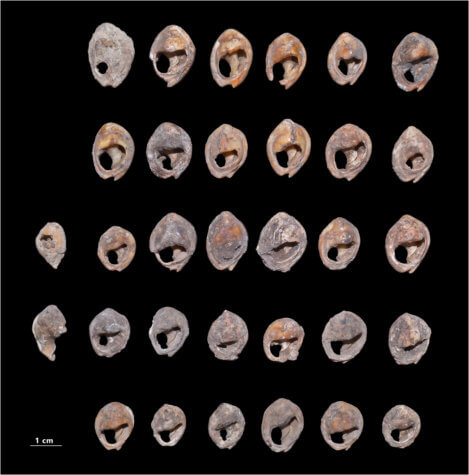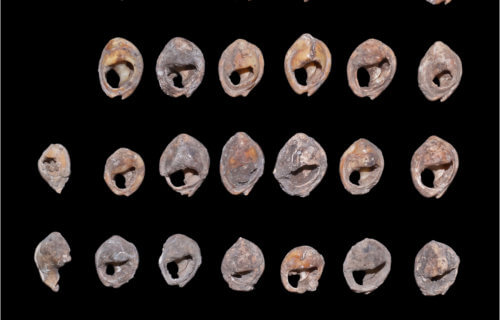TUCSON, Ariz. — Archaeologists may have discovered the earliest form of “bling” ever found. A collection of ancient beads dating back at least 142,000 years were unearthed in a Moroccan cave.
The 33 beads made from sea snail shells measure roughly half an inch long and have holes in their center, indicating they were hung on strings or animal skin garments.
“They were probably part of the way people expressed their identity with their clothing,” says Steven Kuhn, a professor of anthropology with the University of Arizona’s College of Social and Behavioral Sciences, in a statement. “They’re the tip of the iceberg for that kind of human trait. They show it was present even hundreds of thousands of years ago. Humans were interested in communicating to bigger groups of people than their immediate friends and family.”

It turns out modern humans aren’t the only ones who enjoy making fashion statements. The beads, dug up 10 miles inland from Essaouira, a city on the Atlantic coast of Morocco, suggest the behavior goes back much further. They are the earliest known evidence of a habit seen across communities today.
The discovery sheds fresh light on the evolution of cognitive abilities and social interactions.
“You think about how society works – somebody’s tailgating you in traffic, honking their horn and flashing their lights, and you think, ‘What’s your problem?'” says Kuhn. “But if you see they’re wearing a blue uniform and a peaked cap, you realize it’s a police officer pulling you over.”
How were these ancient beads used?
The beads were made by the technologically advanced Aterians – a Middle Stone Age culture centered in North Africa. They were known for making distinctive stemmed spear points to hunt big game such as gazelles, wildebeest, warthogs and rhinoceros.
Scientists have long been interested in when language appeared. The first material record only comes from a few thousand years ago when humans began writing things down. The beads, scientists say, are essentially a fossilized form of basic communication.
“We don’t know what they meant, but they’re clearly symbolic objects deployed in a way that other people could see them,” says Kuhn.
The beads are also notable for their lasting form. Rather than painting their bodies or faces with ochre or charcoal, as many people did, they provided something more permanent. It suggests the intended message was a lasting and important one.
In many ways, the beads raise more questions than they answer. The international team is now investigating why the Aterians felt the need to make the jewelry. One theory involves a growing population. More people occupying North Africa may have increased the importance of identification.
It’s also possible they started using the method of communication at a time when the climate was cold and dry. They may have developed clans or other allegiances to protect limited resources.
The beads would have expressed ethnicity or to show other groups they belonged in a certain area.
“It’s one thing to know people were capable of making them,” says Kuhn. “But then the question becomes, ‘OK, what stimulated them to do it?'”
The findings are published in Science Advances.
South West News Service writer Mark Waghorn contributed to this report.
